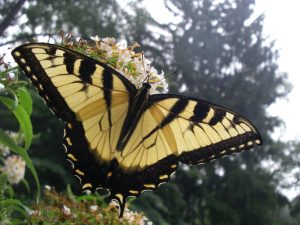This is the time of year when deer begin to roam. Food is
becoming less available, and they are looking for new places to dine. Will they
choose your yard?
Deer can do tremendous damage. They feed on ornamental
plants and rub the bark off young trees with their antlers. If the weather is
harsh, they’ll eat nearly any plant they can reach, and often kill or damage
young shrubs and trees. A plant
not commonly browsed during the summer may become a food source for deer as the
weather becomes cold. Deep or persistent snow cover on the ground for extended
periods may also cause deer to seek new browsing areas.
Deer feeding habits are affected by:
1) Experience and previous movement patterns
2) Nutritional needs
3) Plant palatability
4) Seasonal plant availability
5) Weather conditions
6) Geographic area
7) Availability of alternative foods
Planting deer-resistant plants can help minimize damage.
Plants promoted as deer resistant tend to have hairy, rough, or spiny stem and
leaf texture, or have aromatic stems or leaves. However, plants not damaged in
one region may be damaged in other areas, and when deer are hungry enough, they
will eat anything.
There are numerous repellents on the market for deer.
Consistent use of chemical repellents may be a temporary deterrent, especially
if deer traffic is light or the deer have not become accustomed to feeding in
the area. Alternating different formulations is more effective than constantly
using the same repellent.
Netting can be used; deer can’t chew through it. A fence
is effective if it is about eight feet tall so deer can’t jump over it, and low
to the ground so they can’t squeeze under it. Deer don’t like to leap a barrier
that is high and wide, so if you use a fence, make it as wide as it is high by
installing it at a 45-degree angle, sloped away from your property.
Other measures include laying a band of wire fencing flat
on the ground or using an electric fence in a straight, slanted, or
double-fencing arrangement.
Radios, blinking lights, or motion-triggered water sprays in the garden
frighten deer, but these tend to be short-term solutions, if they work at all.
Deer are a major challenge in our area, and are
particularly difficult to discourage once they have become used to feeding in a
particular area. For this reason, it is best to begin a deterrent program early
and be consistent throughout the growing season.
Have you visited the Chester County Master Gardeners on
Facebook? https://www.facebook.com/ChesterCountyMasterGardeners
* Nancy Sakaduski is the Chester County
Master Gardener Coordinator. Master Gardeners are trained volunteers who
educate the public on gardening and horticultural issues. In Chester
County, they operate through the Penn State Cooperative Extension office in
West Chester. Nancy lives in Pennsbury Township. She can be reached
at nds13@psu.edu.
About Nancy Sakaduski
Nancy Sakaduski is a Master Gardiner with Penn State Extension of Chester County.




Comments